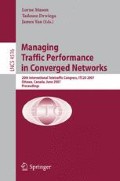Abstract
What are the big movements in networking that researchers should heed? A standout is the global spread of communities of interest (the networking analogue of the flat world) and their need for “dynamic virtual networks” that support rich applications requiring resources from several domains. The imperative for inter-networking, i.e., the enablement of coordinated sharing of resources across multiple domains, is certain. This challenge has many facets, ranging from the organizational, e.g., different, possibly competing, owners to the technical, e.g., different technologies. Yet another key characteristic of the emerging networking environment is that the service provider is required to handle ever-increasing uncertainty in demand, both in volume and time. On the other hand there are new instruments available to handle the challenge. Thus, inter-networking and uncertainty management are important challenges of emerging networking that deserve attention from the research community.
We describe research that touch on both topics. First, we consider a model of data-optical inter-networking, where routes connecting end-points in data domains are concatenation of segments in the data and optical domains. The optical domain in effect acts as a carrier’s carrier for multiple data domains. The challenge to inter-networking stems from the limited view that the data and optical domains have of each other. Coordination has to be enabled through parsimonious and qualitatively restrictive information exchange across domains. Yet the overall optimization objective, which is to maximize end-to-end carried traffic with minimum lightpath provisioning cost, enmeshes data and optical domains. This example of inter-networking also involves two technologies. A mathematical reflection of the latter fact is the integrality of some of the decision variables due to wavelengths being the bandwidth unit in optical transmission. Through an application of Generalized Bender’s Decomposition the problem of optimizing provisioning and routing is decomposed into sub-problems, which are solved by the different domains and the results exchanged in iterations that provably converge to the global optimum.
In turning to uncertainty management we begin by presenting a framework for stochastic traffic management. Traffic demands are uncertain and given by probability distributions. While there are alternative perspectives (and metrics) to resource usage, such as social welfare and network revenue, we adopt the latter, which is aligned with the service provider’s interests. Uncertainty introduces the risk of misallocation of resources. What is the right measure of risk in networking? We examine various definitions of risk, some taken from modern portfolio theory, and suggest a balanced solution. Next we consider the optimization of an objective which is a risk-adjusted measure of network revenue. We obtain conditions under which the optimization problem is an instance of convex programming. Studies of the properties of the solution show that it asymptotically meets the stochastic efficiency criterion. Service providers’ risk mitigation policies are suggested. For instance, by selecting the appropriate mix of long-term contracts and opportunistic servicing of random demand, the service provider can optimize its risk-adjusted revenue. The “efficient frontier”, which is the set of Pareto optimal pairs of mean revenue and revenue risk, is useful to the service provider in selecting its operating point.
Joint work with Qiong Wang and Anwar Walid, Bell Labs, Murray Hill.
Access this chapter
Tax calculation will be finalised at checkout
Purchases are for personal use only
Author information
Authors and Affiliations
Editor information
Rights and permissions
Copyright information
© 2007 Springer-Verlag Berlin Heidelberg
About this paper
Cite this paper
Mitra, D. (2007). Topics in Networking Research. In: Mason, L., Drwiega, T., Yan, J. (eds) Managing Traffic Performance in Converged Networks. ITC 2007. Lecture Notes in Computer Science, vol 4516. Springer, Berlin, Heidelberg. https://doi.org/10.1007/978-3-540-72990-7_3
Download citation
DOI: https://doi.org/10.1007/978-3-540-72990-7_3
Publisher Name: Springer, Berlin, Heidelberg
Print ISBN: 978-3-540-72989-1
Online ISBN: 978-3-540-72990-7
eBook Packages: Computer ScienceComputer Science (R0)

